Peng Wang
UniBYD: A Unified Framework for Learning Robotic Manipulation Across Embodiments Beyond Imitation of Human Demonstrations
Dec 12, 2025Abstract:In embodied intelligence, the embodiment gap between robotic and human hands brings significant challenges for learning from human demonstrations. Although some studies have attempted to bridge this gap using reinforcement learning, they remain confined to merely reproducing human manipulation, resulting in limited task performance. In this paper, we propose UniBYD, a unified framework that uses a dynamic reinforcement learning algorithm to discover manipulation policies aligned with the robot's physical characteristics. To enable consistent modeling across diverse robotic hand morphologies, UniBYD incorporates a unified morphological representation (UMR). Building on UMR, we design a dynamic PPO with an annealed reward schedule, enabling reinforcement learning to transition from imitation of human demonstrations to explore policies adapted to diverse robotic morphologies better, thereby going beyond mere imitation of human hands. To address the frequent failures of learning human priors in the early training stage, we design a hybrid Markov-based shadow engine that enables reinforcement learning to imitate human manipulations in a fine-grained manner. To evaluate UniBYD comprehensively, we propose UniManip, the first benchmark encompassing robotic manipulation tasks spanning multiple hand morphologies. Experiments demonstrate a 67.90% improvement in success rate over the current state-of-the-art. Upon acceptance of the paper, we will release our code and benchmark at https://github.com/zhanheng-creator/UniBYD.
Long-LRM++: Preserving Fine Details in Feed-Forward Wide-Coverage Reconstruction
Dec 11, 2025Abstract:Recent advances in generalizable Gaussian splatting (GS) have enabled feed-forward reconstruction of scenes from tens of input views. Long-LRM notably scales this paradigm to 32 input images at $950\times540$ resolution, achieving 360° scene-level reconstruction in a single forward pass. However, directly predicting millions of Gaussian parameters at once remains highly error-sensitive: small inaccuracies in positions or other attributes lead to noticeable blurring, particularly in fine structures such as text. In parallel, implicit representation methods such as LVSM and LaCT have demonstrated significantly higher rendering fidelity by compressing scene information into model weights rather than explicit Gaussians, and decoding RGB frames using the full transformer or TTT backbone. However, this computationally intensive decompression process for every rendered frame makes real-time rendering infeasible. These observations raise key questions: Is the deep, sequential "decompression" process necessary? Can we retain the benefits of implicit representations while enabling real-time performance? We address these questions with Long-LRM++, a model that adopts a semi-explicit scene representation combined with a lightweight decoder. Long-LRM++ matches the rendering quality of LaCT on DL3DV while achieving real-time 14 FPS rendering on an A100 GPU, overcoming the speed limitations of prior implicit methods. Our design also scales to 64 input views at the $950\times540$ resolution, demonstrating strong generalization to increased input lengths. Additionally, Long-LRM++ delivers superior novel-view depth prediction on ScanNetv2 compared to direct depth rendering from Gaussians. Extensive ablation studies validate the effectiveness of each component in the proposed framework.
Imagine in Space: Exploring the Frontier of Spatial Intelligence and Reasoning Efficiency in Vision Language Models
Nov 16, 2025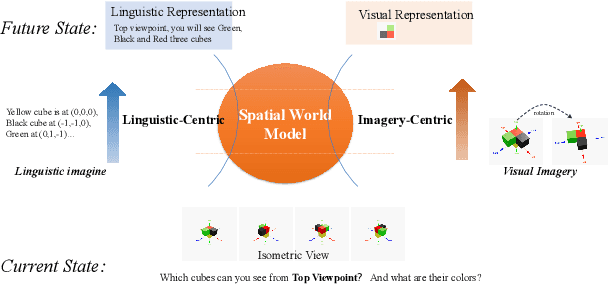
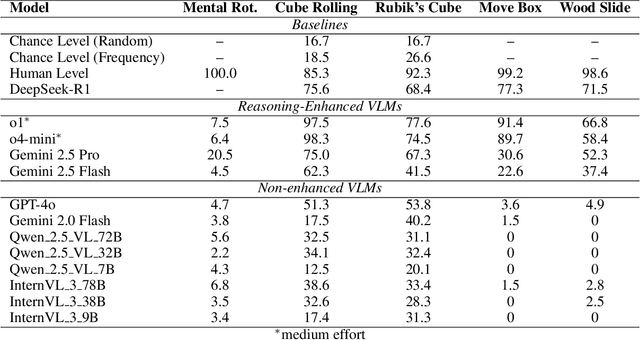
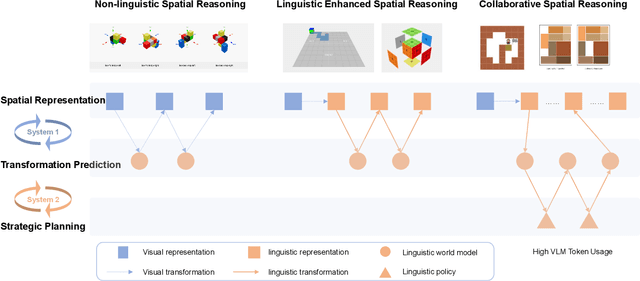

Abstract:Large language models (LLMs) and vision language models (VLMs), such as DeepSeek R1,OpenAI o3, and Gemini 2.5 Pro, have demonstrated remarkable reasoning capabilities across logical inference, problem solving, and decision making. However, spatial reasoning:a fundamental component of human cognition that includes mental rotation, navigation, and spatial relationship comprehension remains a significant challenge for current advanced VLMs. We hypothesize that imagination, the internal simulation of spatial states, is the dominant reasoning mechanism within a spatial world model. To test this hypothesis and systematically probe current VLM spatial reasoning mechanisms, we introduce SpatiaLite, a fully synthetic benchmark that jointly measures spatial reasoning accuracy and reasoning efficiency. Comprehensive experiments reveal three key findings. First, advanced VLMs predominantly rely on linguistic representations for reasoning and imagination, resulting in significant deficiencies on visual centric tasks that demand perceptual spatial relations and 3D geometry transformations such as mental rotation or projection prediction. Second, advanced VLMs exhibit severe inefficiency in their current spatial reasoning mechanisms, with token usage growing rapidly as transformation complexity increases. Third, we propose an Imagery Driven Framework (IDF) for data synthesis and training, which can implicitly construct an internal world model that is critical for spatial reasoning in VLMs. Building on SpatiaLite, this work delineates the spatial reasoning limits and patterns of advanced VLMs, identifies key shortcomings, and informs future advances
From Structure to Detail: Hierarchical Distillation for Efficient Diffusion Model
Nov 12, 2025Abstract:The inference latency of diffusion models remains a critical barrier to their real-time application. While trajectory-based and distribution-based step distillation methods offer solutions, they present a fundamental trade-off. Trajectory-based methods preserve global structure but act as a "lossy compressor", sacrificing high-frequency details. Conversely, distribution-based methods can achieve higher fidelity but often suffer from mode collapse and unstable training. This paper recasts them from independent paradigms into synergistic components within our novel Hierarchical Distillation (HD) framework. We leverage trajectory distillation not as a final generator, but to establish a structural ``sketch", providing a near-optimal initialization for the subsequent distribution-based refinement stage. This strategy yields an ideal initial distribution that enhances the ceiling of overall performance. To further improve quality, we introduce and refine the adversarial training process. We find standard discriminator structures are ineffective at refining an already high-quality generator. To overcome this, we introduce the Adaptive Weighted Discriminator (AWD), tailored for the HD pipeline. By dynamically allocating token weights, AWD focuses on local imperfections, enabling efficient detail refinement. Our approach demonstrates state-of-the-art performance across diverse tasks. On ImageNet $256\times256$, our single-step model achieves an FID of 2.26, rivaling its 250-step teacher. It also achieves promising results on the high-resolution text-to-image MJHQ benchmark, proving its generalizability. Our method establishes a robust new paradigm for high-fidelity, single-step diffusion models.
ScaleADFG: Affordance-based Dexterous Functional Grasping via Scalable Dataset
Nov 12, 2025Abstract:Dexterous functional tool-use grasping is essential for effective robotic manipulation of tools. However, existing approaches face significant challenges in efficiently constructing large-scale datasets and ensuring generalizability to everyday object scales. These issues primarily arise from size mismatches between robotic and human hands, and the diversity in real-world object scales. To address these limitations, we propose the ScaleADFG framework, which consists of a fully automated dataset construction pipeline and a lightweight grasp generation network. Our dataset introduce an affordance-based algorithm to synthesize diverse tool-use grasp configurations without expert demonstrations, allowing flexible object-hand size ratios and enabling large robotic hands (compared to human hands) to grasp everyday objects effectively. Additionally, we leverage pre-trained models to generate extensive 3D assets and facilitate efficient retrieval of object affordances. Our dataset comprising five object categories, each containing over 1,000 unique shapes with 15 scale variations. After filtering, the dataset includes over 60,000 grasps for each 2 dexterous robotic hands. On top of this dataset, we train a lightweight, single-stage grasp generation network with a notably simple loss design, eliminating the need for post-refinement. This demonstrates the critical importance of large-scale datasets and multi-scale object variant for effective training. Extensive experiments in simulation and on real robot confirm that the ScaleADFG framework exhibits strong adaptability to objects of varying scales, enhancing functional grasp stability, diversity, and generalizability. Moreover, our network exhibits effective zero-shot transfer to real-world objects. Project page is available at https://sizhe-wang.github.io/ScaleADFG_webpage
Multi-period Learning for Financial Time Series Forecasting
Nov 07, 2025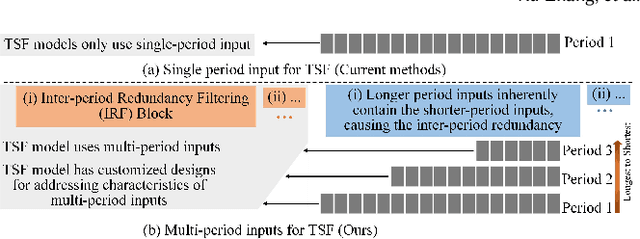

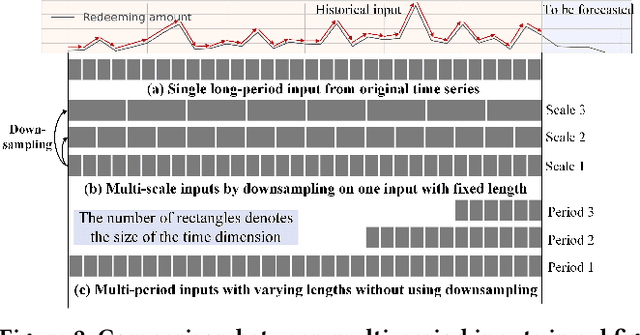

Abstract:Time series forecasting is important in finance domain. Financial time series (TS) patterns are influenced by both short-term public opinions and medium-/long-term policy and market trends. Hence, processing multi-period inputs becomes crucial for accurate financial time series forecasting (TSF). However, current TSF models either use only single-period input, or lack customized designs for addressing multi-period characteristics. In this paper, we propose a Multi-period Learning Framework (MLF) to enhance financial TSF performance. MLF considers both TSF's accuracy and efficiency requirements. Specifically, we design three new modules to better integrate the multi-period inputs for improving accuracy: (i) Inter-period Redundancy Filtering (IRF), that removes the information redundancy between periods for accurate self-attention modeling, (ii) Learnable Weighted-average Integration (LWI), that effectively integrates multi-period forecasts, (iii) Multi-period self-Adaptive Patching (MAP), that mitigates the bias towards certain periods by setting the same number of patches across all periods. Furthermore, we propose a Patch Squeeze module to reduce the number of patches in self-attention modeling for maximized efficiency. MLF incorporates multiple inputs with varying lengths (periods) to achieve better accuracy and reduces the costs of selecting input lengths during training. The codes and datasets are available at https://github.com/Meteor-Stars/MLF.
Global Feature Enhancing and Fusion Framework for Strain Gauge Time Series Classification
Nov 07, 2025



Abstract:Strain Gauge Status (SGS) recognition is crucial in the field of intelligent manufacturing based on the Internet of Things, as accurate identification helps timely detection of failed mechanical components, avoiding accidents. The loading and unloading sequences generated by strain gauges can be identified through time series classification (TSC) algorithms. Recently, deep learning models, e.g., convolutional neural networks (CNNs) have shown remarkable success in the TSC task, as they can extract discriminative local features from the subsequences to identify the time series. However, we observe that only the local features may not be sufficient for expressing the time series, especially when the local sub-sequences between different time series are very similar, e.g., SGS data of aircraft wings in static strength experiments. Nevertheless, CNNs suffer from the limitation in extracting global features due to the nature of convolution operations. For extracting global features to more comprehensively represent the SGS time series, we propose two insights: (i) Constructing global features through feature engineering. (ii) Learning high-order relationships between local features to capture global features. To realize and utilize them, we propose a hypergraph-based global feature learning and fusion framework, which learns and fuses global features for semantic consistency to enhance the representation of SGS time series, thereby improving recognition accuracy. Our method designs are validated on industrial SGS and public UCR datasets, showing better generalization for unseen data in SGS recognition.
Deep Learning in Dental Image Analysis: A Systematic Review of Datasets, Methodologies, and Emerging Challenges
Oct 23, 2025



Abstract:Efficient analysis and processing of dental images are crucial for dentists to achieve accurate diagnosis and optimal treatment planning. However, dental imaging inherently poses several challenges, such as low contrast, metallic artifacts, and variations in projection angles. Combined with the subjectivity arising from differences in clinicians' expertise, manual interpretation often proves time-consuming and prone to inconsistency. Artificial intelligence (AI)-based automated dental image analysis (DIA) offers a promising solution to these issues and has become an integral part of computer-aided dental diagnosis and treatment. Among various AI technologies, deep learning (DL) stands out as the most widely applied and influential approach due to its superior feature extraction and representation capabilities. To comprehensively summarize recent progress in this field, we focus on the two fundamental aspects of DL research-datasets and models. In this paper, we systematically review 260 studies on DL applications in DIA, including 49 papers on publicly available dental datasets and 211 papers on DL-based algorithms. We first introduce the basic concepts of dental imaging and summarize the characteristics and acquisition methods of existing datasets. Then, we present the foundational techniques of DL and categorize relevant models and algorithms according to different DIA tasks, analyzing their network architectures, optimization strategies, training methods, and performance. Furthermore, we summarize commonly used training and evaluation metrics in the DIA domain. Finally, we discuss the current challenges of existing research and outline potential future directions. We hope that this work provides a valuable and systematic reference for researchers in this field. All supplementary materials and detailed comparison tables will be made publicly available on GitHub.
Feature Space Adaptation for Robust Model Fine-Tuning
Oct 22, 2025



Abstract:Catastrophic forgetting is a common issue in model fine-tuning, especially when the downstream domain contains limited labeled data or differs greatly from the pre-training distribution. Existing parameter-efficient fine-tuning methods operate in the weight space by modifying or augmenting the pre-trained model's parameters, which can yield models overly specialized to the available downstream data. To mitigate the risk of overwriting pre-trained knowledge and enhance robustness, we propose to fine-tune the pre-trained model in the feature space. Two new fine-tuning methods are proposed: LoRFA (Low-Rank Feature Adaptation) and VeFA (Vector-Based Feature Adaptation). Feature space adaptation is inspired by the idea of effect equivalence modeling (EEM) of downstream lurking variables causing distribution shifts, which posits that unobserved factors can be represented as the total equivalent amount on observed features. By compensating for the effects of downstream lurking variables via a lightweight feature-level transformation, the pre-trained representations can be preserved, which improves model generalization under distribution shift. We evaluate LoRFA and VeFA versus LoRA on image classification, NLU, and NLG, covering both standard fine-tuning metrics and robustness. Feature space adaptation achieves comparable fine-tuning results and consistently stronger robustness.
ToolExpander: Extending the Frontiers of Tool-Using Reinforcement Learning to Weak LLMs
Oct 09, 2025Abstract:Training Large Language Models (LLMs) with Group Relative Policy Optimization (GRPO) encounters a significant challenge: models often fail to produce accurate responses, particularly in small-scale architectures. This limitation not only diminishes performance improvements and undermines the potential of GRPO but also frequently leads to mid-training collapse, adversely affecting stability and final efficacy. To address these issues, we propose ToolExpander, a novel framework that advances tool-oriented reinforcement learning for resource-constrained LLMs through two key innovations:(1) Dynamic Multi-Round Hard Sampling, which dynamically substitutes challenging samples(those without correct outputs over 10 rollouts) with high-quality few-shot demonstrations during training, coupled with an exponential learning rate decay strategy to mitigate oscillations;(2) Self-Exemplifying Thinking, an enhanced GRPO framework that eliminates KL divergence and incorporates adjusted clipping coefficients, encouraging models to autonomously generate and analyze few-shot examples via a minimal additional reward (0.01).Experimental results demonstrate that ToolExpander significantly enhances tool-using capabilities in LLMs, especially in weaker small-scale models, improving both training stability and overall performance.
 Add to Chrome
Add to Chrome Add to Firefox
Add to Firefox Add to Edge
Add to Edge